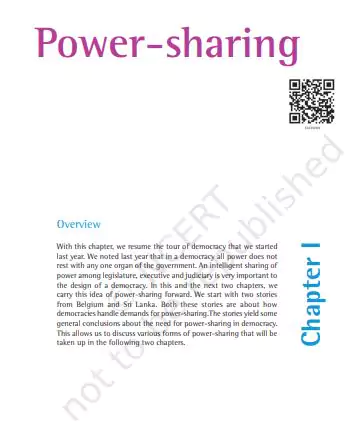‘NCERT Solutions for Class 10 Social Science Chapter 1 Power Sharing‘ PDF Quick download link is given at the bottom of this article. You can see the PDF demo, size of the PDF, page numbers, and direct download Free PDF of ‘Ncert Class 10 Social Science Chapter 1 Exercise Solution’ using the download button.
Power Sharing PDF Free Download

Chapter 1: Power Sharing
Belgium is a small country in Europe, smaller in area than the state of Haryana. It has borders with France, the Netherlands, Germany, and Luxembourg. It has a population of a little over one crore, about half the population of Haryana.
The ETHNIC composition of this small country is very complex. Of the country’s total population, 59 percent lives in the Flemish region and speak Dutch language. Another 40 percent of people live in the Wallonia region and speak French.
The remaining one percent of the Belgians speak German. In the capital city Brussels, 80 percent people speak French while 20 percent are Dutch-speaking. The minority French-speaking community was relatively rich and powerful.
This was resented by the Dutch-speaking community who got the benefit of economic development and education much later. This led to tensions between the Dutch-speaking and French-speaking communities during the 1950s and 1960s. The tension between the two communities was more acute in Brussels.
Brussels presented a special problem: the Dutch-speaking people constituted a majority in the country, but a minority in the capital. Let us compare this to the situation in another country. Sri Lanka is an island nation, just a few kilometers off the southern coast of Tamil Nadu.
It has about two crore people, about the same as in Haryana. Like other nations in the South Asia region, Sri Lanka has a diverse population. The major social groups are Sinhala speakers (74 percent) and Tamil speakers (18 percent).
Among Tamils, there are two sub-groups. Tamil natives of the country are called ‘Sri Lankan Tamils’ (13 percent). The rest, whose forefathers came from India as plantation workers during the colonial period, are called ‘Indian Tamils’.
As you can see from the map, Sri Lankan Tamils are concentrated in the north and east of the country. Most of the Sinhala- speaking people are Buddhists, while most of the Tamils are Hindus or Muslims. There is about 7 percent of Christians, are both Tami and Sinhala. Just imagine what could happen in situations like this.
In Belgium, the Dutch community could take advantage of its numeric majority and force its will on the French and German-speaking populations. This would push the conflict among communities further. This could lead to a very messy partition of the country; both sides would claim control over Brussels. In Sri Lanka, the Sinhala community enjoyed an even bigger majority and could impose its will on the entire country.
Now, let us look at what happened in both of these countries. Sri Lanka emerged as an independent country in 1948. The leaders of the Sinhala community sought to secure dominance over a government by virtue of their majority. As a result, the democratically elected government adopted a series of MAJORITARIAN measures to establish Sinhala supremacy.
In 1956, an Act was passed to recognize Sinhala as the only official language, thus disregarding Tamil. The governments followed preferential policies that favored Sinhala applicants for university positions and government jobs.
A new constitution stipulated that the state shall protect and foster Buddhism. All these government measures, coming one after the other, gradually increased the feeling of alienation among the Sri Lankan Tamils. They felt that none of the major political parties led by the Buddhist Sinhala leaders was sensitive to their language and culture.
| Author | NCERT |
| Language | English |
| No. of Pages | 12 |
| PDF Size | 1.9 MB |
| Category | Social Science |
| Source/Credits | ncert.nic.in |
NCERT Solutions Class 11 Social Science Chapter 1 Power Sharing
1. What are the different forms of power-sharing in modern democracies? Give an example of each of these.
Answer.
There are different forms of power-sharing in modern democracies. These are given below:
- Horizontal distribution of power – Power is shared among different organs of government, such as the legislature, executive and judiciary. Example – India
- The federal division of power – Power can be shared among governments at different levels – a general government for the entire country and governments at the provincial or regional level. Example – India (Union Government & State Government)
- Community government – Power may also be shared among different social groups such as the religious and linguistic groups. Example – Belgium
- Power-sharing between political parties, pressure groups and movements – Such competition ensures that power does not remain in one hand. In the long run, power is shared among different political parties that represent different ideologies and social groups.
2. State one prudential reason and one moral reason for power-sharing with an example from the Indian context.
Answer.
While prudential reasons stress that power-sharing will bring out better outcomes. In India, the power is shared horizontally among various organs of government. The Legislature, Executive and Judiciary are responsible for administering India. Reservation is applicable in India, where various sections are given benefits over others to avoid conflicts.
Moral reasons emphasise the very act of power-sharing as valuable. In India, citizens are conferred with fundamental rights and directive principles of state policies are implied on the government.
NCERT Class 11 Social Science Textbook Chapter 1 With Answer PDF Free Download
